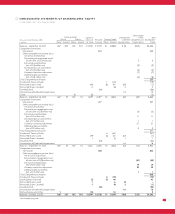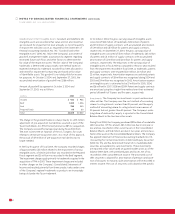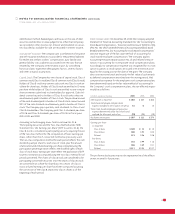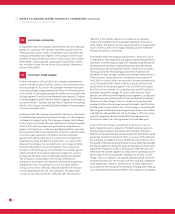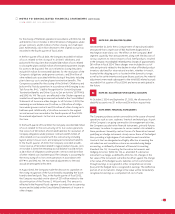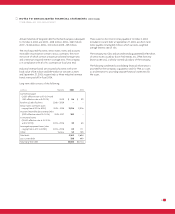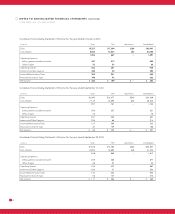Tyson Foods 2004 Annual Report Download - page 37
Download and view the complete annual report
Please find page 37 of the 2004 Tyson Foods annual report below. You can navigate through the pages in the report by either clicking on the pages listed below, or by using the keyword search tool below to find specific information within the annual report.
35
NOTES TO CONSOLIDATED FINANCIAL STATEMENTS (CONTINUED)
identification method. Realized gains and losses on the sale of debt
securities and declines in value judged to be other than temporary
are recorded in other income, net. Interest and dividends on securi-
ties classified as available-for-sale are recorded in interest income.
The Company uses a combination of insurance
and self-insurance mechanisms to provide for the potential liabilities
for health and welfare, workers’ compensation, auto liability and
general liability risks. Liabilities associated with the risks that are
retained by the Company are estimated, in part, by considering
historical claims experience demographic factors, severity factors
and other actuarial assumptions.
The Company has two classes of capital stock, Class A
common stock (Class A stock) and Class B common stock (Class B stock).
Holders of Class B stock may convert such stock into Class A stock on
a share-for-share basis. Holders of Class B stock are entitled to 10 votes
per share while holders of Class A stock are entitled to one vote per
share on matters submitted to shareholders for approval. Cash divi-
dends cannot be paid to holders of Class B stock unless they are
simultaneously paid to holders of Class A stock. The per share amount
of the cash dividend paid to holders of Class B stock cannot exceed
90% of the cash dividend simultaneously paid to holders of Class A
stock. The Company pays quarterly cash dividends to Class A and
Class B shareholders. The Company paid Class A dividends per share
of $0.16 and Class B dividends per share of $0.144 in fiscal years
2004, 2003 and 2002.
According to the Emerging Issues Task Force Issue No. 03-6,
“Participating Securities and the Two-Class Method under FASB
Statement No. 128, Earnings per Share” (EITF Issue No. 03-6), the
Class B stock is considered a participating security requiring the use
of the two-class method for the computation of basic earnings per
share, rather than the if-converted method as previously used.
The two-class computation method for each period reflects the cash
dividends paid per share for each class of stock, plus the amount
of allocated undistributed earnings per share computed using the
participation percentage which reflects the dividend rights of each
class of stock. Basic earnings per share reflect the application of EITF
Issue No. 03-6 and was computed using the two-class method for all
periods presented. The shares of Class B stock are considered to be
participating convertible securities since the shares of Class B stock
are convertible on a share-for-share basis into shares of Class A
stock. Diluted earnings per share have been computed assuming
the conversion of the Class B shares into Class A shares as of the
beginning of each period.
On December 29, 2002, the Company adopted
Statement of Financial Accounting Standards No. 148, “Accounting for
Stock-Based Compensation – Transition and Disclosure” (SFAS No. 148).
SFAS No. 148, which amended Financial Accounting Standards Board
(FASB) Statement No. 123, “Accounting for Stock-Based Compensation,”
does not require use of the fair value method of accounting for
stock-based employee compensation. The Company applies
Accounting Principles Board Opinion No. 25 and related interpre-
tations in accounting for its employee stock compensation plans.
Accordingly, no compensation expense was recognized for its stock
option issuances as stock options are issued with an exercise price
equal to the closing price at the date of the grant. The Company
does issue restricted stock and records the fair value of such awards
as deferred compensation amortized over the vesting period. Had
compensation expense for the employee stock compensation plans
been determined based on the fair value method of accounting for
the Company’s stock compensation plans, the tax-effected impact
would be as follows:
in millions, except per share data 2004 2003 2002
Net income as reported $403 $ 337 $ 383
Stock-based employee compensation
expense included in net income, net of tax 16 16 15
Total stock-based employee compensation
expense determined under fair value based
method for all awards, net of tax (22) (20) (19)
Pro forma net income $397 $ 333 $ 379
Earnings per share
As reported
Class A Basic $1.20 $1.00 $1.13
Class B Basic 1.08 0.90 1.02
Diluted 1.13 0.96 1.08
Pro forma
Class A Basic 1.18 0.99 1.12
Class B Basic 1.06 0.89 1.01
Diluted $1.11 $0.95 $1.07
The pro forma disclosures may not be representative of the effects
on net income for future years.








